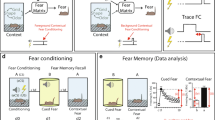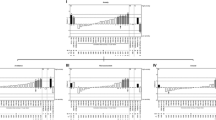Abstract
We used short-term selection to produce outbred mouse lines with differences in contextual fear conditioning. Within two generations of selection all low selected mice were homozygous for the recessive tyrc allele and showed the corresponding albino coat color. Freezing differed in the high and low selected lines across a range of parameters. We identified several QTLs for the selection response, including a highly significant QTL at the tyr locus (p < 9.6−10). To determine whether the tyrc allele was directly responsible for the response to selection, we examined B6 mice that have a mutant tyr allele (tyrc−2j−) and an AJ congenic strain that has the wild-type B6 allele for tyr. These studies showed that the tyr allele had a small influence on fear learning. We used Affymetrix microarrays to identify many differentially expressed genes in the amygdala and hippocampus of the selected lines. We conclude that tyr is one of many alleles that influence fear conditioning.







Similar content being viewed by others
References
Beermann F, Orlow SJ, Lamoreux ML (2004) The Tyr (albino) locus of the laboratory mouse. Mamm Genome 15:749–758
Belknap JK, Richards SP, O’Toole LA, Helms ML, Phillips TJ (1997) Short-term selective breeding as a tool for QTL mapping: ethanol preference drinking in mice. Behav Genet 27:55–66
Caldarone B, Saavedra C, Tartaglia K, Wehner JM, Dudek BC, Flaherty L (1997) Quantitative trait loci analysis affecting contextual conditioning in mice [see comments]. Nat Genet 17:335–337
Churchill GA, Airey DC, Allayee H, Angel JM, Attie AD, Beatty J, Beavis WD, Belknap JK, Bennett B, Berrettini W, Bleich A, Bogue M, Broman KW, Buck KJ, Buckler E, Burmeister M, Chesler EJ, Cheverud JM, Clapcote S, Cook MN, Cox RD, Crabbe JC, Crusio WE, Darvasi A, Deschepper CF, Doerge RW, Farber CR, Forejt J, Gaile D, Garlow SJ, Geiger H, Gershenfeld H, Gordon T, Gu J, Gu W, de Haan G, Hayes NL, Heller C, Himmelbauer H, Hitzemann R, Hunter K, Hsu HC, Iraqi FA, Ivandic B, Jacob HJ, Jansen RC, Jepsen KJ, Johnson DK, Johnson TE, Kempermann G, Kendziorski C, Kotb M, Kooy RF, Llamas B, Lammert F, Lassalle JM, Lowenstein PR, Lu L, Lusis A, Manly KF, Marcucio R, Matthews D, Medrano JF, Miller DR, Mittleman G, Mock BA, Mogil JS, Montagutelli X, Morahan G, Morris DG, Mott R, Nadeau JH, Nagase H, Nowakowski RS, O’Hara BF, Osadchuk AV, Page GP, Paigen B, Paigen K, Palmer AA, Pan HJ, Peltonen-Palotie L, Peirce J, Pomp D, Pravenec M, Prows DR, Qi Z, Reeves RH, Roder J, Rosen GD, Schadt EE, Schalkwyk LC, Seltzer Z, Shimomura K, Shou S, Sillanpaa MJ, Siracusa LD, Snoeck HW, Spearow JL, Svenson K, Tarantino LM, Threadgill D, Toth LA, Valdar W, de Villena FP, Warden C, Whatley S, Williams RW, Wiltshire T, Yi N, Zhang D, Zhang M, Zou F, Complex Trait C (2004) The Collaborative Cross, a community resource for the genetic analysis of complex traits. Nat Genet 36:1133–1137
Cohen RM, Kang A, Gulick C (2001) Quantitative trait loci affecting the behavior of A/J and CBA/J intercross mice in the elevated plus maze. Mamm Genome 12:501–507
Crabbe JC, Wahlsten D, Dudek BC (1999) Genetics of mouse behavior: interactions with laboratory environment [see comment]. Science 284:1670–1672
DeFries JC (1969) Pleiotropic effects of albinism on open field behaviour in mice. Nature 221:65–66
Gentleman RC, Carey VJ, Bates DM, Bolstad B, Dettling M, Dudoit S, Ellis B, Gautier L, Ge Y, Gentry J, Hornik K, Hothorn T, Huber W, Iacus S, Irizarry R, Leisch F, Li C, Maechler M, Rossini AJ, Sawitzki G, Smith C, Smyth G, Tierney L, Yang JY, Zhang J (2004) Bioconductor: open software development for computational biology and bioinformatics. Genome Biol 5:R80
Gershenfeld HK, Paul SM (1997) Mapping quantitative trait loci for fear-like behaviors in mice. Genomics 46:1–8
Gershenfeld HK, Paul SM (1998) Towards a genetics of anxious temperament: from mice to men. Acta Psychiatr Scand Suppl 393:56–65
Henry KR, Schlesinger K (1967) Effects of the albino and dilute loci on mouse behavior. J Comp Physiol Psychol 63:320–323
Irizarry RA, Hobbs B, Collin F, Beazer-Barclay YD, Antonellis KJ, Scherf U, Speed TP (2003) Exploration, normalization, and summaries of high density oligonucleotide array probe level data. Biostatistics 4:249–264
Katz RJ, Doyle RL (1981) The albino locus and locomotor behavior in the mouse: studies using extended test intervals. Behav Genet 11:167–172
LeDoux J (2003) The emotional brain, fear, and the amygdala. Cell Mol Neurobiol 23:727–738
Lissek S, Powers AS, McClure EB, Phelps EA, Woldehawariat G, Grillon C, Pine DS (2005) Classical fear conditioning in the anxiety disorders: a meta-analysis. Behav Res Ther 43:1391–1424
Meier GW, Foshee DP (1965) Albinism and water escape performance in mice. Science 147:307–308
Moehler E, Kagan J, Brunner R, Wiebel A, Kaufmann C, Resch F (2006) Association of behavioral inhibition with hair pigmentation in a European sample. Biol Psychol 72:344–346
Owen EH, Logue SF, Rasmussen DL, Wehner JM (1997) Assessment of learning by the Morris water task and fear conditioning in inbred mouse strains and F1 hybrids: implications of genetic background for single gene mutations and quantitative trait loci analyses. Neuroscience 80:1087–1099
Palmer AA, Verbitsky M, Suresh R, Kamens HM, Reed CL, Li N, Burkhart-Kasch S, McKinnon CS, Belknap JK, Gilliam TC, Phillips TJ (2005) Gene expression differences in mice divergently selected for methamphetamine sensitivity. Mamm Genome 16:291–305
Petkov PM, Ding Y, Cassell MA, Zhang W, Wagner G, Sargent EE, Asquith S, Crew V, Johnson KA, Robinson P, Scott VE, Wiles MV (2004) An efficient SNP system for mouse genome scanning and elucidating strain relationships. Genome Res 14:1806–1811
Phillips TJ, Shen EH, McKinnon CS, Burkhart-Kasch S, Lessov CN, Palmer AA (2002) Forward, relaxed, and reverse selection for reduced and enhanced sensitivity to ethanol’s locomotor stimulant effects in mice. Alcohol Clin Exp Res 26:593–602
Ponder CA, Kliethermes CL, Drew MR, Muller J, Das K, Risbrough VB, Crabbe JC, Gilliam TC, Palmer AA (2007a) Selection for contextual fear conditioning affects anxiety-like behaviors and gene expression. Genes Brains Behav 6:736–749
Ponder CA, Munoz M, Gilliam TC, Palmer AA (2007b) Genetic architecture of fear conditioning in chromosome substitution strains: relationship to measures of innate (unlearned) anxiety-like behavior. Mamm Genome 18:221–228
Rachel RA, Mason CA, Beermann F (2002) Influence of tyrosinase levels on pigment accumulation in the retinal pigment epithelium and on the uncrossed retinal projection. Pigment Cell Res 15:273–281
Radcliffe RA, Lowe MV, Wehner JM (2000) Confirmation of contextual fear conditioning QTLs by short-term selection. Behav Genet 30:183–191
Rhoades RW, Henry KR (1977) Effects of single albino gene substitutions on the performance of mice in a compound avoidance-discrimination task. Physiol Behav 19:87–92
Storey JD, Tibshirani R (2003) Statistical methods for identifying differentially expressed genes in DNA microarrays. Meth Mol Biol 224:149–157
Stylianou IM, Tsaih SW, Dipetrillo K, Ishimori N, Li R, Paigen B, Churchill G (2006) Complex genetic architecture revealed by analysis of high-density lipoprotein cholesterol in chromosome substitution strains and f2 crosses. Genetics. 174:999–1007
Talbot CJ, Radcliffe RA, Fullerton J, Hitzemann R, Wehner JM, Flint J (2003) Fine scale mapping of a genetic locus for conditioned fear. Mamm Genome 14:223–230
van Abeelen JH, Kroes HW (1968) Albinism and mouse behaviour. Genetica 38:419–429
Veenstra-VanderWeele J, Qaadir A, Palmer AA, Cook EH Jr, de Wit H (2006) Association between the casein kinase 1 epsilon gene region and subjective response to d-amphetamine. Neuropsychopharmacology 31:1056–1063
Winston HC, Lindzey G (1964) Albinism and water escape performance in the mouse. Science 144:189–191
Acknowledgments
We wish to thank Dr. Greta Sokoloff for her scientific input during the preparation of this manuscript. This work was supported by MH70933, MH79103, T32GM07088, T32GM07839, a Howard Hughes Undergraduate Summer Fellowship, a NARSAD young investigator award and a Schweppe Foundation Career Development Award.
Author information
Authors and Affiliations
Corresponding author
Additional information
Edited by Stephen Maxson.
Rights and permissions
About this article
Cite this article
Ponder, C.A., Huded, C.P., Munoz, M.B. et al. Rapid Selection Response for Contextual Fear Conditioning in a Cross Between C57BL/6J and A/J: Behavioral, QTL and Gene Expression Analysis. Behav Genet 38, 277–291 (2008). https://doi.org/10.1007/s10519-008-9203-6
Received:
Accepted:
Published:
Issue Date:
DOI: https://doi.org/10.1007/s10519-008-9203-6




